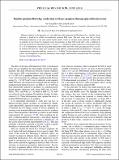Tunable quantum Hall edge conduction in bilayer graphene through spin-orbit interaction
Author(s)
Khoo, Jun Yong; Levitov, Leonid
DownloadPhysRevB.98.115307.pdf (1.078Mb)
PUBLISHER_POLICY
Publisher Policy
Article is made available in accordance with the publisher's policy and may be subject to US copyright law. Please refer to the publisher's site for terms of use.
Terms of use
Metadata
Show full item recordAbstract
Bilayer graphene, in the presence of a one-sided spin-orbit interaction (SOI) induced by a suitably chosen substrate, is predicted to exhibit unconventional quantum Hall states. The new states arise due to strong SOI-induced splittings of the eight zeroth Landau levels, which are strongly layer polarized, residing fully or partially on one of the two graphene layers. In particular, an Ising SOI on the meV scale is sufficient to invert the Landau level order between the n=0 and n=1 orbital levels under moderately weak magnetic fields B≲10 T. Furthermore, when the Ising field opposes the B field, the order of the spin-polarized levels can also be inverted. We show that, under these conditions, three different compensated electron-hole phases, with equal concentrations of electrons and holes, can occur at ν=0 filling. The three phases have distinct edge conductivity values. One of the phases is especially interesting, since its edge conduction can be turned on and off by switching the sign of the interlayer bias.
Date issued
2018-09Department
Massachusetts Institute of Technology. Department of PhysicsJournal
Physical Review B
Publisher
American Physical Society
Citation
Khoo, Jun Yong, and Leonid Levitov. “Tunable Quantum Hall Edge Conduction in Bilayer Graphene through Spin-Orbit Interaction.” Physical Review B, vol. 98, no. 11, Sept. 2018. © 2018 American Physical Society
Version: Final published version
ISSN
2469-9950
2469-9969